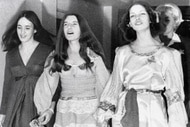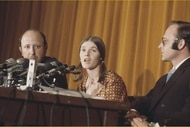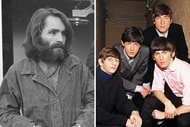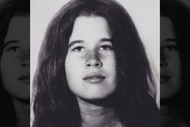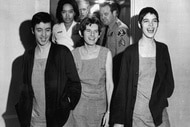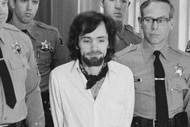Create a free profile to get unlimited access to exclusive videos, breaking news, sweepstakes, and more!
‘Wasn’t What I Would Call A Bad Person’: Charles Manson’s Family Friends, Experts Describe Difficult Childhood
Charles Manson's early years were shaped by his teen mother's arrest for robbery and a strict uncle who once forced him to go to elementary school in a dress.

Before Charles Manson earned his place in history as the enigmatic cult leader who led his followers to savagely murder actress Sharon Tate and her friends — he had been a young, impressionable boy with his own set of demons.
“I’d have to say when a child was treated the way he was, you’re doomed,” family friend Virginia Brautigan said in the new EPIX docuseries “Helter Skelter: An American Myth” of Manson’s difficult childhood. “I don’t think you stand much of a chance. I mean, he could have gone a different way. I don’t know, I guess the cards didn’t fall that way, but he wasn’t what I would call a bad person.”
The docuseries provides new insights into Manson’s early years and what shaped one of the country’s most powerful cult leaders. The series runs through his teen mother’s arrest for a robbery gone wrong, to his traumatizing visits to prison to visit her and the strict disciplinarian who raised him in his mother’s absence — even sending the young boy to elementary school one day in a girl’s dress.
But even with the significant obstacles Manson faced as a young child, Jeff Guinn argued in the docuseries that Manson had always been a “disagreeable child” who created problems for others.
Guinn is an investigative journalist who wrote the book "Manson: The Life and Times Of Charles Manson."
“Wherever he lived, he would have been a problem because he whined most of the time, he complained, he would just fib incessantly about everything,” Guinn said.
Manson’s powers of manipulation also set in at an early age — making Manson a formidable foe and a danger to others, even in elementary school.
A Cult Leader Is Born
Manson was born on Nov. 12, 1934 to 16-year-old Kathleen Maddox and was originally referred to as “no-name Maddox,” according to according to local station WCPO. But the young baby boy, was eventually named Charles Milles Manson, in honor of his late grandfather.
Manson’s mother — just a teen herself — had come from a strict, religious background, but she frequently rebelled from the teachings of the Nazarene church her mother embraced.
“There was a lot of rebellion as there always has been with young people growing up under fundamentalist church rules. But Charlie’s mother Kathleen was really the exception in that she would actually dare to put up her hair, sneak into a short dress that might leave her arms bare which was just a carnal act, and go out to dance,” Guinn said in the docuseries.
Once she got pregnant, Guinn said she was “pretty much held up as an example” to her peers as a cautionary tale of how not to behave.
There’s been speculation over the years about who Manson’s biological father was, but Guinn contends that it was Colonel Walker Henderson Scott Sr. — an older, married man who Kathleen had met at a dance hall.
Manson was given his surname after Kathleen married another man named William Manson.
“He was somebody that had apparently also met Kathleen at the dance halls,” Guinn said. “He married her and he went into the marriage well aware that his wife was pregnant with another man’s child.”
In his early years, Charles Manson was always moving from one spot to another — living in Cincinnati, Ohio; Ashland, Kentucky and McMechen, West Virginia.
The marriage between his mother and William wouldn’t last long. Charles Manson and his mother often sought refuge with other relatives.
Manson’s Mom Heads To Prison
When Charles was just four and a half years old, his mother Kathleen and her brother Luther were arrested for robbing and assaulting a man.
Kathleen and Luther’s girlfriend, Julia, had reportedly been out on the town when they met a man at a club who they thought had a lot of money, Guinn told the docuseries. The pair called Luther who told them to lure the man to a gas station where he would be waiting.
“Luther shows up, he has in his possession a ketchup bottle filled with salt, which he tries to stick in the guy’s back and say, ‘this is a gun, I’ve got you covered, give me your money,’” Guinn said.
But the man realized it wasn't a real gun and began to challenge Luther — who smashed the bottle over his head and robs him before taking off in his stolen car.
A 1939 article in the Charleston Daily Mail would refer to the crime as the “ketchup bottle hold-up,” according to the Charleston Gazette-Mail. The article claimed the man was robbed of $35 and was knocked unconscious.
Kathleen was sentenced to five years behind bars for the robbery and her brother received a 10-year sentence.
While she was serving out her sentence at the West Virginia state prison in Moundsville, Charles lived with his grandmother, Uncle Bill, and Aunt Glenna in McMechen, West Virginia.
One of Charles' first memories, according to Guinn, is walking into the “draconian prison” to visit his mother.
“The prison in Moundsville is one of the most intimidating places possible,” Guinn said. “It looks like some old, medieval castle.”
For years, Charles was forced to visit his mother in the “bleak” prison and was never able to hug his mom. He was only able to see her through thick glass and she sat amongst other more serious criminals, like rapists and murderers.
The visits were traumatizing for Charles, but his Uncle Bill — who Guinn described as a “stern disciplinarian” — insisted he continue to make the treks to prison.
“Charlie screams and he acts girlie and a sissy and Uncle Bill is disgusted and drags him off but on a regular basis, never wanting to go because the place was so awful,” Guinn said. “Little Charlie Manson would be taken to see his mother in that prison and every time he had a terrible reaction. He never got used to it, but then who would?”
In a strange twist, after Charles was arrested himself for first-degree murder and conspiracy to commit murder for the deaths of seven people, he wrote to the warden at the West Virginia Penitentiary and asked to be transferred to the prison where his mother had also once served time, according to an 1983 UPI article.
“He apparently grew up in the Benwood-McMechen area, which is just a few miles from here,” then-Warden Donald Bordenkircher said at the time. “Some of his relatives did time in the facility here, and he said they helped build a lot of the roads in the area. He just wanted to carry on the family tradition, I guess.”
West Virginia authorities were not allowed to accept transfers at the time, but Bordenkircher seemed opposed to the idea, saying “it will be a cold day in hell,” before he would agree to having the infamous inmate.
Traumatizing School Days
Charles Manson also had a difficult time at school as a young boy, according to those who knew him.
He was placed into the classroom of a first-grade teacher with a notorious reputation for being mean, Brautigan said.
“I would never want one of my children to be in her class. I mean the way she ran her class was the way you would run a prison,” Brautigan said in the docuseries. “In her class, you were placed with what she deemed your intelligence, so she would place people together, the dumb-dumbs and the smart kids and the ones in the middle, and Charles was placed in the back of the room.”
After the first day of school, Charles came home sobbing but he wouldn’t find any sympathy from his uncle who was “horrified” that young boy was crying.
Guinn said Charles’ cousin Jo Ann remembers her father picking out a dress from her closet and forcing Charles to wear it to school soon after.
Early Signs Of Violence
Charles Manson’s childhood may have been filled with trauma, but there were also disturbing signs of the violent and manipulative man he would grow to become.
In the book “Manson: The Life and Times Of Charles Manson” Guinn wrote that Charles would often “recruit gullible classmates, mostly girls to attack other students he didn’t like,” according to Metro News.
“Afterward, he’d swear to teachers that his kid followers were just doing what they wanted — he couldn’t be held responsible for their actions. Because no one thought a six-year-old could be capable of such manipulation, Charlie usually got off scot-free while his disciples were punished,” Guinn wrote.
Guinn also wrote in the book about another incident when Charles was seven and at home with his cousin Jo Ann. She told him to go play outside while she changed the bed linens on the family’s beds but Charles soon came back with a “razor-sharp sickle” and waved it in her face.
“Bigger and stronger than her scrawny cousin, she pushed him out of the way and continued tucking in the sheets,” Guinn wrote. “Charlie jumped between her and the bed; Jo Ann shoved him outside and locked the screen door behind him.”
But Charles began slashing at the screen door with the sickle — terrifying his cousin.
“There was a crazy look on his face. Jo Ann had no doubt that her cousin was going to kill her,” Guinn wrote. “He had cut through the screen and was wrenching the door open when Bill and Glenna Thomas drove up.”
She would later tell Guinn she was “not surprised” after he was arrested in 1969 alongside his followers for the brutal murders that shocked a nation.
Honing His Craft
A penchant for violence wasn’t the only skill Charles picked up as a child that would later serve him as an adult.
Even as a young boy, Charles was drawn to music and often practiced on the “old beat up upright piano” at his aunt and uncle’s house.
“Much more so than the other young kids in McMechen, he was already picking up on what passed for the popular music of the day,” Guinn said in the docuseries.
Charles once told a reporter he came from the “heart of Bing Crosby, Frank Sinatra” and tried to become a musician himself.
His melodic folk songs were often what drew many of his followers in the Manson Family into his circle, along with this preaching and ideas. Some believe Charles' inability to make it in the music world enraged the cult leader and may have even helped drive the horrific violence that made Charles Manson a household name.
Guinn said in "Helter Skelter" that many of his beliefs were taken from lessons he learned as a child in church.
“Charlie Manson is a sponge,” he said. “There is nothing unique about Manson in any of his philosophies, any of the things he preaches. What he would do is he would cherry pick lines that would help him appear to have a philosophy and it starts with the Bible that he learns in the church of the Nazarene.”
Reuniting With His Mom
Although Kathleen was given a five year sentence for robbery, she was paroled after three years and reunited with her son — but the reunion “isn’t any kind of fairytale,” according to Guinn.
“When she gets out of prison, she stays briefly in McMechen,” he said. “She’s got her little boy back but there’s still the influence of her mother who she thinks is just going to grind her down like she did the first time.”
Kathleen still wanted to be able to go out on the town and pursue her life away from her watchful mother, so she and Charles moved from town to town. Eventually, Kathleen got a job as a clerk in a grocery store.
“She’s trying to be a good mom,” Guinn said in the docuseries. “She’s sending her son to school except he won’t go to school. She can take him there, walk him to class, but then she has to go to work and the minute she does, he disappears.”
Van Watson, who owned Van’s Never Closed Market where Kathleen once worked, told the Charleston Gazette-Mail that he remembered a young Manson often coming into the store.
He described the boy as “nothing outstanding” and “ordinary.”
“I sold him a lot of candy,” Watson said.
Reform Schools And Prisons
Kathleen continued to struggle to get Charles to stay in school and eventually decided to send him to the Gibault School For Boys in Terre Haute when he was 13 years old, according to The Indianapolis Star Tribune.
But Charles soon ran away from the school and returned home. His mother would often ask the teen to get out of the house while she “entertained her boyfriends,” the paper reported. She was later arrested on adultery charges.
Charles later addressed rumors himself that his mother had worked as a prostitute.
“In later years, because of hard knocks and tough times, she may have sold her body some. I am not about to knock her," he wrote in his autobiography, according to WCPO. "Knowing the things I know now, I wish my mother had been smart enough to start out as a prostitute. You can sit back and say ‘A statement like that is about what is expected out of Manson’s mouth,’ but to me, a class whore is about as honest a person as there is on earth. She has a commodity that is hers alone. She asks a price for it. If the price is agreeable, the customer is happy, the girl has her rent and grocery money."
In 1949, when Charles was 14-years-old, he was ordered by a judge to go to Boys Town in Nebraska after he caught for a string of burglaries, KMA Land reported. Boys Town is a well-known children's home started by Father Edward Flanagan, designed to give troubled children a new start.
Charles was even captured in a news photo showing him shaking the head of Marion County Juvenile Judge Joseph Hoffman, with a headline that read “Dream Comes True For Lad; He’s Going To Boys Town.”
But Charles would only stay at the prestigious boys school for a few days.
Guinn said in the docuseries that after just four days, Charles and some other boys stole a car belonging to a priest and fled.
He would spend the next few decades bouncing in and out of reform schools and prisons for everything from stealing to forgery.
According to Guinn, Charles was often a target of bullying.
"In the tougher reform schools, it is absolutely true that Charlie Manson, one of the smaller, weaker boys is certainly picked on, he certainly suffers physical indignities and we can be fairly well assured he is sexually assaulted," Guinn said in the docuseries.
Guinn also claimed that Charles was also violent toward other boys and was even once caught sodomizing another reform student, while holding a piece of glass to this throat.
"When he would be asked about having been raped as a child in school, Charlie said, 'so what?'," Guinn said. "It's just like if it happens you wipe it off."
Charles Manson was sent away to prison for the first time in 1951.
James Buddy Day, a film producer and director who talked extensively with Manson before his death and the showrunner for Oxygen’s documentary “Manson: The Women,” told Oxygen.com that Manson was eventually sent to federal prison on a seven-year stint for a forgery after Manson claimed he tried to cash a check he said he won in a poker game.
He was released from prison in 1967 and soon headed to San Francisco where he would begin recruiting women for what would later be known as the Manson Family. The group eventually traveled to Los Angeles, paving the way for him to become one of the most notorious cult leaders and murderers in American history.
Charles Manson's story ultimately ended in prison again, where he died of natural causes in 2017 while serving a life sentence.
